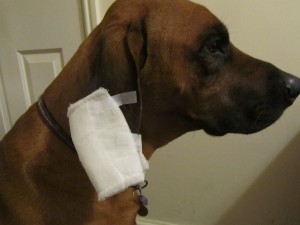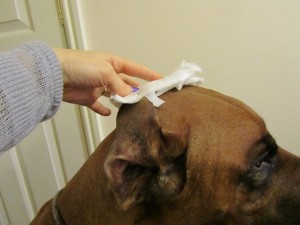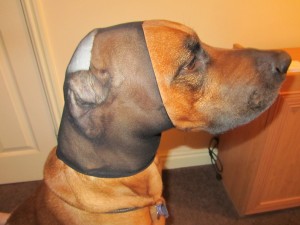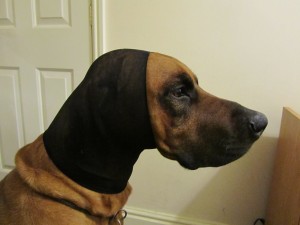Ears – Basic 1st Aid for …… Constant shaking/scratching
* Examine the ear opening by lifting the ear flap and looking inside.
* Provided it is near the very top of the ear canal, if you are able to see an obvious foreign body, you can remove this yourself gently with your fingers. If you must use a pair of blunt tipped tweezers, be very careful not to push the object deeper into the ear canal.
* Never probe deeply into the ear and always be aware that the dog may shake his head or move suddenly while you are trying to help. Therefore, be mindful that the tweezers do not damage him further and also that you do not get yourself bitten (its a good idea to use plastic tweezers rather than sharp metal ones).
* If you think your dog may have something like a grass seed in his ear, rather than trying to reach far down with tweezers in this risky fashion, trying filling up the affected ear with olive oil or mineral oil. Sometimes, this will float the seed up so that it can be easily removed. This technique can also be applied if the dog has managed to get an insect in his ear canal. In order that insects can actually fly and get off the ground, they weigh very little and so administering olive oil to the ear canal may well float these out too.
Remember that the seed can easily migrate further down the canal or even penetrate the ear drum or side walls due to the barb like tip. If the dog shakes his head, this may mean the seed is lodged deeper in the ear canal. Deep seeds should always be removed by a vet and never left to work their way out on by themselves.
To soothe the dog temporarily, simply use the olive/mineral oil but be ready for the imminent shake the minute to put it in! A pipette or small turkey baster is ideal for this job but please make sure the contents are dropped in carefully rather than squirted in under pressure.
N.B. It is worth remembering that if your dog shakes his head, it may be that he is suffering with ear mites rather than simply having a foreign body in the ear canal.
* Constant scratching risks damage to the ear, ear flap or side of the face. Fit a protective Elizabethan or Buster collar until the problem can be dealt with properly.
*If in any doubt, do nothing until veterinary advice has been taken.
Bleeding Ear Flap Wounds:
1) Apply a wound dressing over the ear tip and hold firmly in place with microporous tape
2) Fold the ear so that it lies across the top of the dog’s head
3) Hold the ear in place on top of the head with the leg of a pair of tights, like a snood. Leave the ear and dressing in place like this for at least 5 minutes to give the blood time to clot. (NB ensure that the stocking is not too tight and does not inhibit breathing)
4) Remove the dressing and replace the ear into its normal position and then re-apply the the stocking to keep the ear pressed to the side of the head to prevent re-opening if the dog should shake his head.
A small split in the ear tip should be controlled fairly well using this method – you’ll need to keep the stocking in place for an hour or so. A more severe split may require your dog to wear his fashionable new look for as much as a week or two!
Simply applying styptic powder or even corn starch flour to the tip should help stop the bleeding but for more stubborn splits, it might be worth investing in some veterinary grade super glue. Ensure that the ear is thoroughly clean before application.
Stings & Allergic Reactions
Stings and allergic reactions to the ears can be dealt with as follows:-
*Apply an ice pack, frozen peas or bathe the ear flap with cool water.
*If the sting is visible, remove by scraping the stinger towards the tip of the ear using a credit card on a diagonal angle. DO NOT use tweezers or your fingers to pinch the stinger as this will inject further sting into your dog’s ear.
* If you have been prescribed antihistamine for THIS PARTICULAR dog before, then give an antihistamine tablet. Your vet will have explained the correct dosage for the size and weight of your animal and also specified when it can be re-administered should the reaction not respond well enough.
*Monitor for allergic reaction to the sting and if this becomes severe, ‘phone your vet immediately to inform him you are on the way to the clinic.






